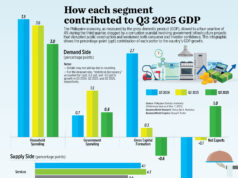Philippines is 33rd best country to live in – report
PHL places 33rd in ranking of best countries
The ranking by US News & World Report, together with BAV Consulting and the Wharton School of the University of Pennsylvania, showed the countries in terms of “Quality of Life,” “Open for Business,” “Entrepreneurship,” and other categories.
Alongside its modest ranking, the Philippines scored low in several areas of public service, at a time when this has become a prevalent public concern in an election season.
In “Quality of Life” (overall score: 1.8), the country scored 0.6 in “Safe”; 0.4 in “Well-developed public education system”; 0.3 in “Well-developed public health system” and “Economically stable”; 1.3 in “A good job market”; 0.5 in “Income equality” and “Politically stable”; and a very high 9.5 in “Affordable.” The top five countries in “Quality of Life” are Canada, Sweden, Denmark, Australia, and the Netherlands.
In “Open for Business” (overall score: 6.1), the Philippines scored 6.6 in “Corrupt”; 3.4 in “Favorable tax environment”; 1.5 in “Bureaucratic”; 0.4 in “Transparent government practices”; and a high 9.4 in “Cheap manufacturing costs.” The best countries in this category are Luxembourg, Sweden, Canada, Denmark, and Panama.
In “Entrepreneurship,” the Philippines scored 0.3 in “Well-developed infrastructure” and “Transparent business practices”; 0.2 in “Well-developed legal framework”; 0.5 in “Educated population,” “Innovative,” and “Technological expertise”; 2.1 in “Connected to the rest of the world”’ and 1.8 in “Provides easy access to capital.” The best countries in this category are Germany, Japan, United States, United Kingdom, and Canada.
The category “Citizenship” has the Philippines scoring between 0.1 and 1.8 in the following attributes: “Respects property rights,” “Progressive,” “Trustworthy,” “Gender equality,” “Well-distributed political power,” “Cares about the environment,” “Cares about human rights,” and “Religious freedom.”
In “Adventure,” the country scored 2.2 in “Sexy”; 2.7 in “Fun”; 5.1 in “Friendly”; 5.3 in “Pleasant climate”; and 5.7 in “Scenic.” The top five countries in this category are Brazil, Italy, Spain, Thailand, and New Zealand.
The category “Power” has the Philippines scoring between 0.2 and 0.4 in the following attributes: “Strong military,” “Strong international alliances,” “Economically influential,” “Politically influential,” and “A leader.”
Further, the Philippines ranked 33rd in Best Countries to Headquarter a Corporation, Best Countries to Study Abroad, and Best Countries for Raising Kids; 47th in Most Transparent Countries; 25th in Best Countries to Travel Alone; 41st in Best Countries for Women; 18th in Best Countries to Invest in; and 3rd in Best Countries to Start a Business.
Of the 10 best countries in the overall ranking, two are from the Asia-Pacific — Australia (6th), followed by Japan.
U.S. News said in part, explaining its methodology: “The 60 countries in the 2016 Best Countries rankings are the only countries whose achievements reached four reputable benchmarks: the United Nation’s top 100 countries in terms of 2013 gross domestic product, the World Bank’s top 100 countries in terms of 2012 international tourist arrivals, the top 100 countries in terms of foreign direct investment inflows from the United Nation’s 2013 World Investment Report and the top 150 countries of the United Nation’s 2014 Human Development Index.”
Each ranked country had an accompanying overview. Of the Philippines, it was said: “The land of beautiful beaches and abundant biodiversity has long been plagued by political instability, but its resilient economy continues to improve and push ahead of others in the region.”
“With more than 100 million citizens, the Philippines is the 13th-most populous nation in the world,” the Philippine overview also noted. “Each year, the Philippine economy is flooded with billions of dollars sent home by the large number of Filipinos living abroad. These remittances, along with a flourishing tourism industry, have helped maintain a budget surplus. But the implicit dependence on global trends has proved risky, and opportunities in electronics, petroleum and other goods are being explored.”
“Recent government actions have boosted social spending in an effort to battle high unemployment and manage a rapidly growing population, a quarter of which lives below the poverty line.”
“Foreign investment in the Philippines is low, but frequent devastating tsunamis and other national disasters often draw large amounts of humanitarian aid.”
A total of 16,248 individuals from 36 countries in four regions were surveyed. Of the respondents, 8,092 were informed elites and 4,513 were business decision-makers, while 6,381 respondents were from the general public, the report said. — Kathryn Mae P. Tubadeza




